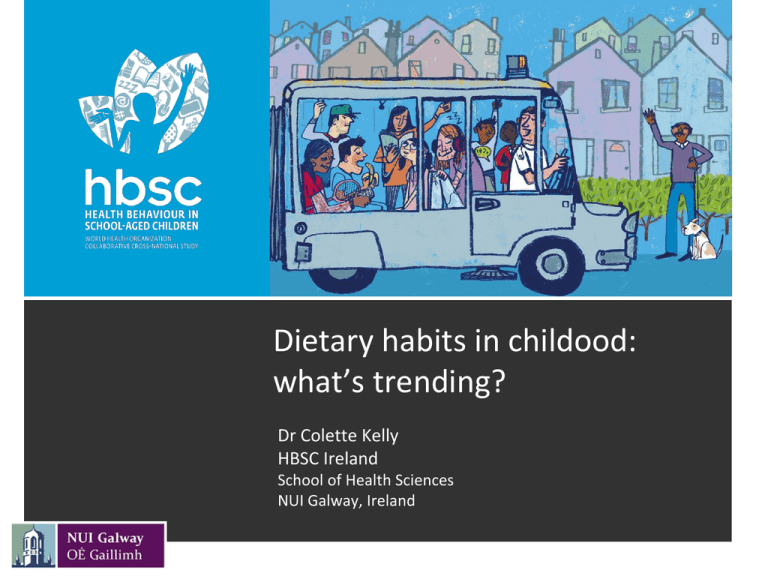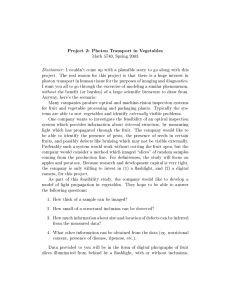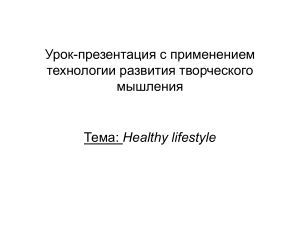Dietary habits in childood: what’s trending? Dr Colette Kelly HBSC Ireland
advertisement

Dietary habits in childood: what’s trending? Dr Colette Kelly HBSC Ireland School of Health Sciences NUI Galway, Ireland Presentation outline • HBSC • Role of nutrition • Fruit and Vegetables • Soft drinks • Breakfast • What can we do? HBSC is an international alliance of over 400 adolescent health experts based in 44 countries who collaborate to develop and execute the HBSC survey. Every 4 years, the HBSC network collects data on 11, 13 and 15 year olds’ health and well-being, social environments and health behaviours. Data are collected through school-based questionnaires; minimum of 1,500 students of each age group per country. The 2013-2014 international dataset includes 219,810 students. To date, more than 1 million young people have participated in this survey. MARK YOUR CALENDAR: 2013/14 International Report Launch 15 March 2016 Brussels The findings from HBSC are used at both a national and international level to: ➔ ➔ gain new insight into young people’s health and well-being inform policy and practice to improve young people’s lives Conceptual framework Age Gender SES Ethnicity Food and nutrition • Healthy diets save lives • Unhealthy eating can lead to CVD, obesity, diabetes and some forms of cancers – the leading cause of death and disease in WHO European region • Variety, balance and moderation is key to healthy diet • Food - for optimal health, fighting illness, preventing disease and the treatment of specific conditions Why child and adolescent nutrition? • Good nutrition is important for growth and development • In general young people do not suffer from serious dietrelated diseases but can have poor nutritional status • Dietary habits may track into adulthood - Emphasis placed on optimising dietary habits during youth • Many health problems in adulthood have their genesis in the childhood and adolescent years - Establishing healthy habits early in life is important Nutrition through childhood Nutrition plays a role at every life stage • Prenatal – folic acid during pregnancy • Infants – breastfeeding and weaning (Vitamin D) • Pre-school – establishing habits, healthy family approach • Schoolchildren – nutrient dense diet (fish, snacks, breakfast) • Adolescence – nutrient dense diet (healthy weight, physically active, iron, calcium) Factors influencing food intake • Diet and obesity is strongly determined by individual, social, cultural and economic factors and physical/built environment • Individual or intrapersonal influences (e.g., psychosocial, biological); • Social environmental or interpersonal (e.g., family and peers); • Physical environment or community settings (e.g., schools, fast food outlets, convenience stores); • Macrosystem or societal (e.g., mass media, marketing and advertising, social and cultural norms) Youth dietary habits • Assessing dietary habits is challenging • Especially across countries • Fruit and vegetables are high priority for most countries • Diets high in fruit and vegetables associated with decreased risk of NCDs • Non-diet soft drinks and sweets (candy/chocolate) are also of interest in context of obesity, dietary quality and dental caries • Breakfast consumption is associated with better diet quality and with healthy body weight Frequency of consumption • How many days a week do you usually eat or drink…? • • • Fruits Vegetables Soft drinks • Response options: • never • less than once a week • once a week • 2-4 days a week • 5-6 days a week • once a day, every day • every day, more than once • Response options were recoded into daily versus less than daily Fruit and vegetable targets • The WHO population goal is at least 400g of fruit and vegetables daily • National recommendations are either close to or above this target (e.g., Spain, Ireland) • Nationally – policies and interventions at home, school and community settings to increase fruit and vegetables • Are adolescents meeting fruit and vegetable targets? EATING BEHAVIOUR: FRUIT CONSUMPTION 40% or more 35-39% 30-34% 25-29% 20-24% Less than 20% No data 31% of 15 year olds consume fruit daily Trends in Fruit and Vegetables • To examine trends in fruit and vegetable intake • cross-nationally • nationally representative samples of adolescents • standardised questionnaires • HBSC 2002, 2006, 2010 • 488,951 11, 13, 15-year olds from 33 countries or regions Analysis • Multilevel logistic regression analyses were conducted for each country separately and pooled for the total sample • Additional analyses were run by gender and age • MLwin version 2.25 was used to perform the three-level analyses (adolescents nested within schools nested within countries). DAILY FRUIT 2010 - Greenland: 15% 2010 - Denmark, Belgium (French): 49% Daily Vegetables 2010 - Estonia: 20% 2010 - Belgium (French): 55% RESULTS • Large differences in daily fruit and vegetable consumption between countries • A significant time trend 2002 to 2010 • increase in daily fruit (OR=1.22 [99% CI: 1.18-1.25]) • increase in daily vegetable (OR=1.20 (99% CI: 1.17-1.22)) • The increase was mainly observed between 2002 and 2006 Country comparisons - fruit • Significant in fruit from 2002 to 2010 in two thirds of the countries • Most pronounced in fruit consumption (OR >1.6) • Denmark, England, Norway, Ukraine, US and Wales • Significant in fruit consumption in 5 countries • Germany, Greenland, Greece, Poland & Portugal • No significant differences in 6 countries •Czech Republic, Spain, Croatia, Macedonia, Sweden & Slovenia Country comparisons - vegetables •Significant in vegetable intake from 2002 to 2010 in 18 countries • The most pronounced in vegetable consumption • Spain, Denmark, Hungary, England, Wales, Greece & Austria (OR >1.6) • A significant in vegetable consumption was found in 5 countries • Germany, Lithuania, Latvia, Poland & Russia • No significant differences were found for 10 countries •Belgium-Flanders, Canada, France, Croatia, Ireland, Italy, the Netherlands, Portugal, Slovenia & Ukraine Gender and Age • In general, girls were more likely to consume fruit and vegetables than boys • Increases in daily fruit and vegetable consumption from 2002 to 2010 were significant for boys as well as for girls • 15 year olds were less likely to consume daily fruit and vegetables than 13 year olds • 13 year olds were less likely to consume daily fruit and vegetables than 11 year olds Summary • Overall a positive trend in fruit and vegetable consumption was observed between 2002 and 2010 • Mainly driven by a significant increase between 2002 and 2006 and plateauing thereafter • May reflect the success of national policies and initiatives implemented in the early 2000’s; educational messages subsidised fruit and vegetables increased fruit and vegetables at schools (e.g., Norway and Denmark) Noteworthy • Large proportions of adolescents do not eat fruit and vegetables on a daily basis • Need for a continued focus on promotion of fruit and vegetable consumption • A review of fruit and vegetable policies and initiatives across countries needed •Additional strategies to increase fruit and vegetables among adolescents are needed. Associations between free sugar intake and measures of body fatness in children (Te Morenga et al., 2012) WHO recommends < 5% total calories/day from sugar EATING BEHAVIOUR: SOFT-DRINK CONSUMPTION 40% or more 30-39% 20-29% 10-19% Less than 10% No data 25% of 15 year olds consume soft drinks daily Breakfast • Regular breakfast consumption is associated with better quality diet, including less frequent use of soft drinks and greater intake of fruit and vegetables • Overweight is generally lower in those who consume breakfast regularly • Skipping breakfast is common among adolescents and is associated with risk behaviours • HBSC: How many days in a week and in a weekend do you have breakfast? (more than a glass of milk or fruit juice) EATING BEHAVIOUR: BREAKFAST CONSUMPTION 70% or more 60-69% 50-59% 40-49% Less than 40% No data 55% of 15 year olds eat breakfast every school day Breakfast (Vereecken et al., 2009) • To investigate associations of daily breakfast consumption (DBC) with demographic and lifestyle factors in 41 countries • DBC varied from 33% (Greek girls) to 75% (Portuguese boys) • In most countries, DBC was higher in boys, younger adolescents, those with higher family affluence and those living in two-parent families • DBC was positively associated with healthy lifestyle behaviours and negatively with unhealthy lifestyle behaviours • DBC can serve as an indicator to identify children at risk for unhealthy lifestyle behaviours Summary • The diet and eating habits of young people is not optimal • Prevalence of obesity - a key public health concern • Creating supportive environments is key - at home, in schools and in clubs/youth organisations What can we do? • Health Promotion focus - to enable people to increase control over and improve their health • Address determinants of health and health inequalities • Create an environment so that the healthy option is the easy choice • Settings approach - such as workplaces/schools/pre-schools through which action can be taken to enable healthy choices What can we do as parents/citizens? • Family meals / food rules – regular meal times, engage family in cooking/shopping • School food – improve health index of food in schools (including vending) • Eating out – environment/planning regulations, calorie labelling, portion size, reformulation of food What can we do as professionals? Promote • • • • • • • • awareness of the role of diet and of obesity healthy lifestyle practices healthy eating and active lifestyles early detection early intervention regular monitoring parent and child interventions – best outcome HBSC is a resource for the pediatric community, work with us. We have unique expertise and knowledge on the social determinants of health for this age group. We must increase our awareness of and integrate young people’s ability to examine their lives into our practice in order to be more effective. MARK YOUR CALENDAR: 2013/14 International Report Launch 15 March 2016 Brussels Cross-sectorial collaboration and cross-fertilisation events such as this one can increase our ability to understand and improve young people’s lives. THANK YOU




